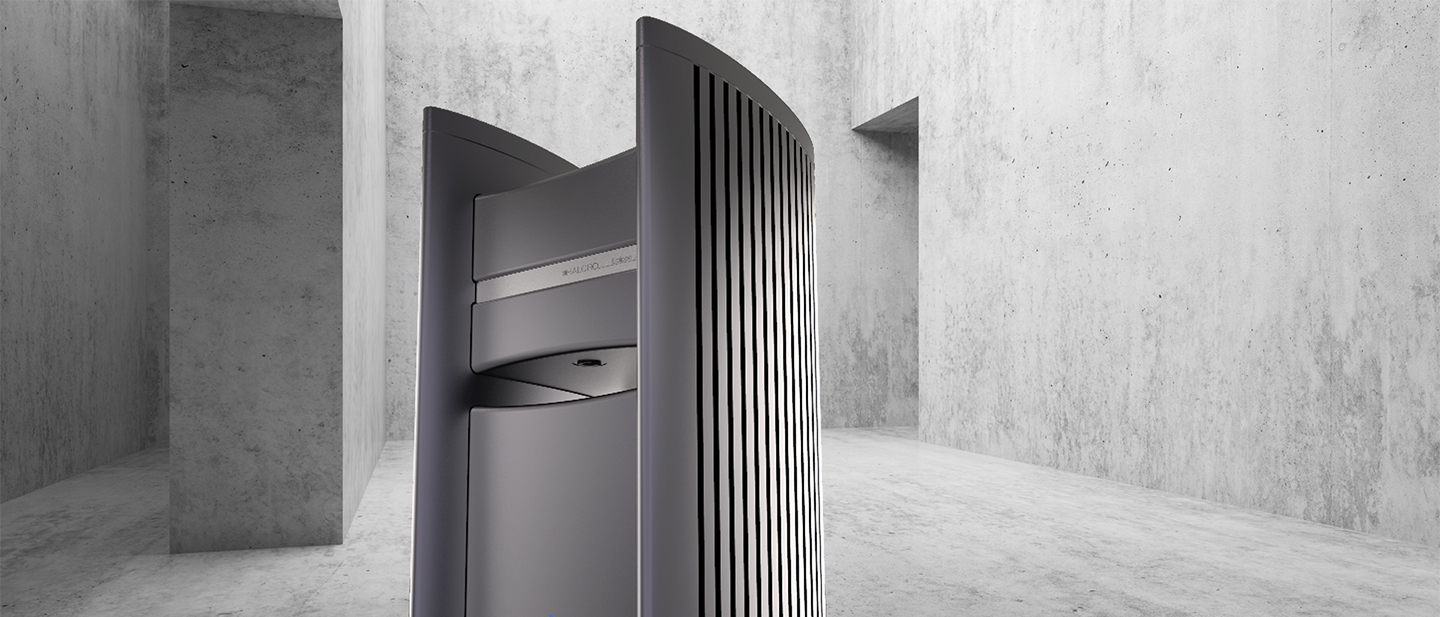What Hi-Fi? Verdict
Pros
- +
Excellent sound and performance
- +
Stunning and stylish appearance
Cons
- -
Huge and heavy
- -
Not inexpensive
Why you can trust What Hi-Fi?
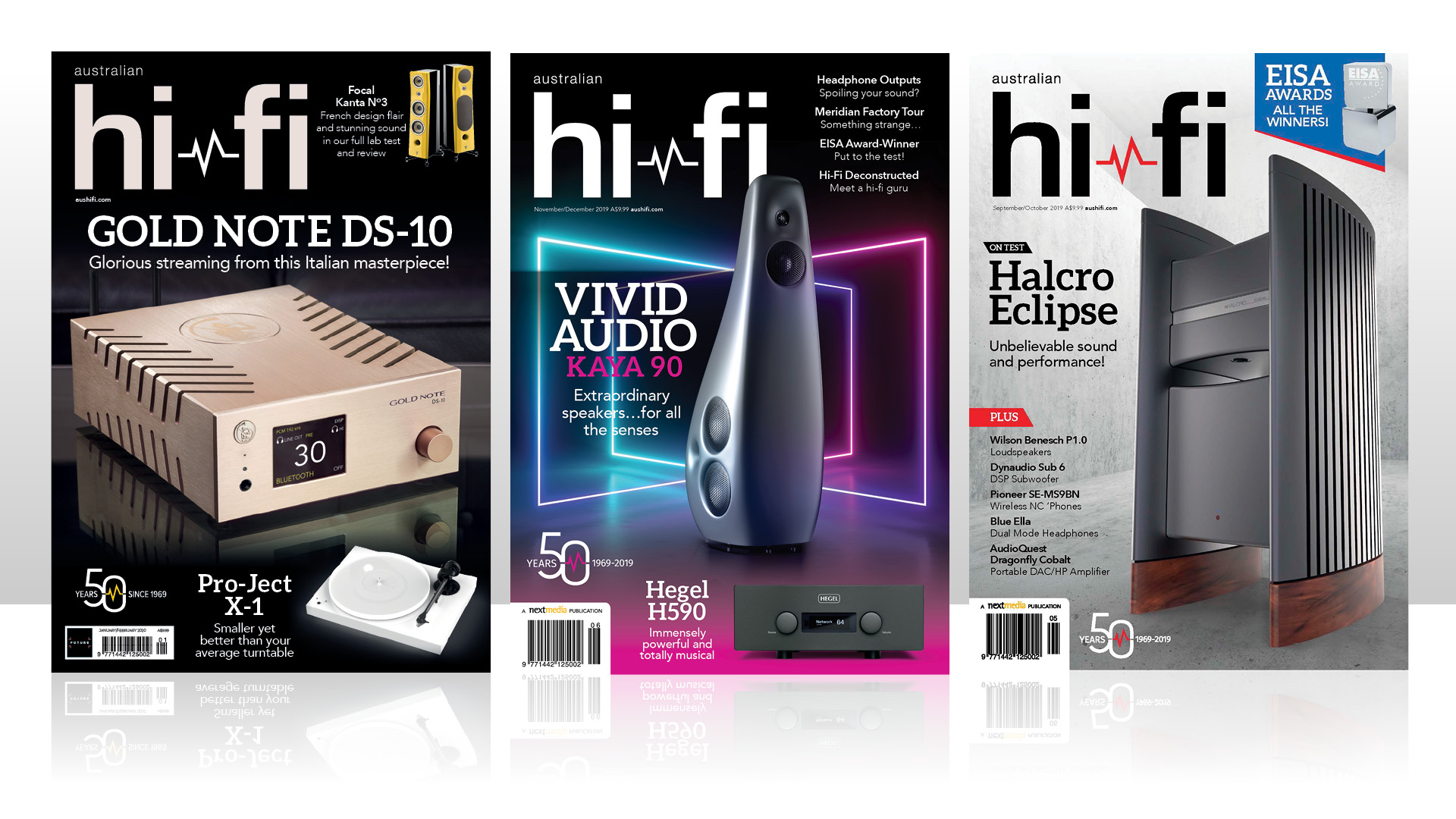
This review and test originally appeared in Australian Hi-Fi magazine, one of What Hi-Fi?’s sister titles from Down Under. Click here for more information about Australian Hi-Fi, including details on how to subscribe.
Halcro is very likely the most famous Australian hi-fi brand you’ve never heard of. Indeed you’re more likely to be familiar with the name of the company that founded it – Minelab – than you are to be with Halcro, since you can buy a Minelab metal detector almost anywhere in the world… which isn’t true of Halcro, at least not yet. Hi-fi and metal detectors – what could these possibly have in common? The answer is quite simple: inventor and physicist Bruce Halcro Candy, who founded both companies.
Equipment
Halcro builds the Eclipse in two versions: a monobloc power amplifier (as reviewed here) and a stereo power amplifier. The model name of both amplifiers is the same, so it is important that I differentiate them by referring to the monoblocs reviewed here as "Eclipse Monos".
However, other than the obvious fact that you need two monoblocs for stereo, Halcro’s new owner, Longwood Audio, says that the Eclipse Mono and Eclipse Stereo use similar circuitry, but differ in their power output capabilities, with the monoblocs being more powerful, at a rated 550 watts into 4Ω, versus 350 watts into 4Ω for the stereo version. The specifications for THD, IMD and TIM are slightly higher than for the Eclipse Mono.
Regarding these three distortions, Longwood Audio says that the new Halcro Eclipse Mono’s figures are lower than that of the original Halcro dm58, an amplifier that was independently proved to have less of these distortions than any other amplifier in the world. To hang some figures on that claim, Halcro says the THD at 1kHz of the Eclipse Mono is more than 140dB down (0.00001%) and that IMD products are more than –126dB (0.00005%) down.
The power supply in the Eclipse Mono is an unusual ultra-low noise 'dual' switch-mode design, where the first switch-mode power supply is used for power factor correction, ensuring that the voltage and current drawn from the mains power socket remain in phase. This first supply generates a high direct-current voltage that feeds a second switch-mode power supply, which creates the final d.c. voltages that power the amplifier’s circuitry.
According to Halcro, as well as the advantages delivered by the power factor correction, the other advantages of its design are that its performance is not affected by load conditions, and that it has much lower noise levels compared with other power factor corrected power supplies. It also has the advantage that it will operate at any mains voltage from 85V through to 270V, and at both 50Hz and 60Hz mains frequencies. This means that the Eclipse Monos will work in any country in the world, irrespective of that country’s mains voltage or frequency.
The Halcro Eclipse Mono’s power supply is totally shielded, and kept physically separate from the amplifier circuitry. All printed circuit boards used in the power supplies are quad-layer types to minimise EMI and voltage transients and improve reliability, and all are populated exclusively by industrial-grade semiconductors and capacitors with 105°C temperature ratings.
The chassis of the Halcro Eclipse Mono is essentially still basically the vertical winged chassis originally developed for the very first Halcro amplifier, the dm58, but for this new Eclipse Mono, Halcro has increased the thickness of the casings to eliminate microphonics and resonances, and has improved the connections between the cases and the main heatsink pillars.
If you closely compare an early-model Halcro with the new Eclipse Mono you will see that the more solid construction has enabled the company to add some extra curves to improve the overall look of the amplifier. However, you certainly won’t have to look hard to see the improvement in the quality of the finish on the metalwork, which is now an aerospace-grade wet-sprayed coating. This not only looks fantastic, but is also very tough and durable.
The circuit boards in the audio power amplifier section of the Eclipse Mono have six layers and, like the power supply section, are populated exclusively by industrial-grade semiconductors. All the electrolytic capacitors have 105°C temperature ratings and only low-impedance polypropylene capacitors and highly linear resistors are employed in the audio path.
The rear of the Halcro Eclipse Mono has four different inputs: one is a standard unbalanced input (with an impedance of 100kΩ) via a gold-plated RCA terminal, one is a standard balanced input (with an impedance of 100kΩ+100kΩ) via a female XLR socket, then there is a 'minimal path' unbalanced input (with an impedance of 600Ω), again via a gold-plated RCA terminal. According to Dr Peter Foster, of Halcro, the minimal path input bypasses one of the internal amplifier gain stages, so whereas the total amplifier gain for the unbalanced input is around 35.6dB, that for the minimal path input is only around 29.5dB. According to Mike Kirkham of Halcro, the minimal path setting "produces great results with higher-efficiency loudspeakers".
The fourth input is a decidedly non-standard 'current mode' input (with an impedance of 60Ω). The three first-mentioned inputs are all 'voltage mode' inputs, meaning that when a voltage is applied to any of them, the Halcro Eclipse Mono amplifies the voltage of the signal to send to the speakers. The fourth ‘current mode’ input requires you to connect a device with a current output to it, and the Eclipse Mono then amplifies the signal current rather than the signal voltage. In current mode, I would expect the amplifier’s bandwidth to be more extended, the slew rate to be faster, and even-lower levels of transient intermodulation distortion.
According to Bruce Candy, the current mode input is "most desirable for minimising earth-loop-generated mains hum and ripple, high frequency interference" as well as to minimise "cable, plug and socket-generated interference".
The only issue I can see with Halcro providing a current input is that so few audio components have the necessary ‘current output’ required to drive it that almost all audiophiles will end up having to use one or the other of the voltage mode inputs. As to the suitability of using these, Candy says the balanced connection is to be preferred over the unbalanced connection, but that "the unbalanced voltage [input] is quite satisfactory as long as earth loop generated mains hum and ripple are not a problem… and they should not be a problem unless the source equipment is poorly designed".
Switching between inputs is done via a single rotary control which means that you could have up to three different source components connected to the Halcro Eclipse Mono and select between them, so if all three had their own volume controls, you could eliminate the need for a pre-amplifier or a control amplifier… which, of course, was J. Gordon Holt’s recommended mode of source/amplifier operation.
Halcro very cleverly does not have any publicity photographs of the Halcro Eclipse Mono amplifiers that show them 'in situ' or even with other audio components in the same shot, so it might come as a surprise when you see a pair ‘in the flesh’ for the first time and realise how large they are! The Halcro Eclipse Mono is 790mm high, 400mm wide and 400 deep. It weighs 55kg. The Halcro Eclipse Mono amplifiers are very obviously intended to be floor-standing!
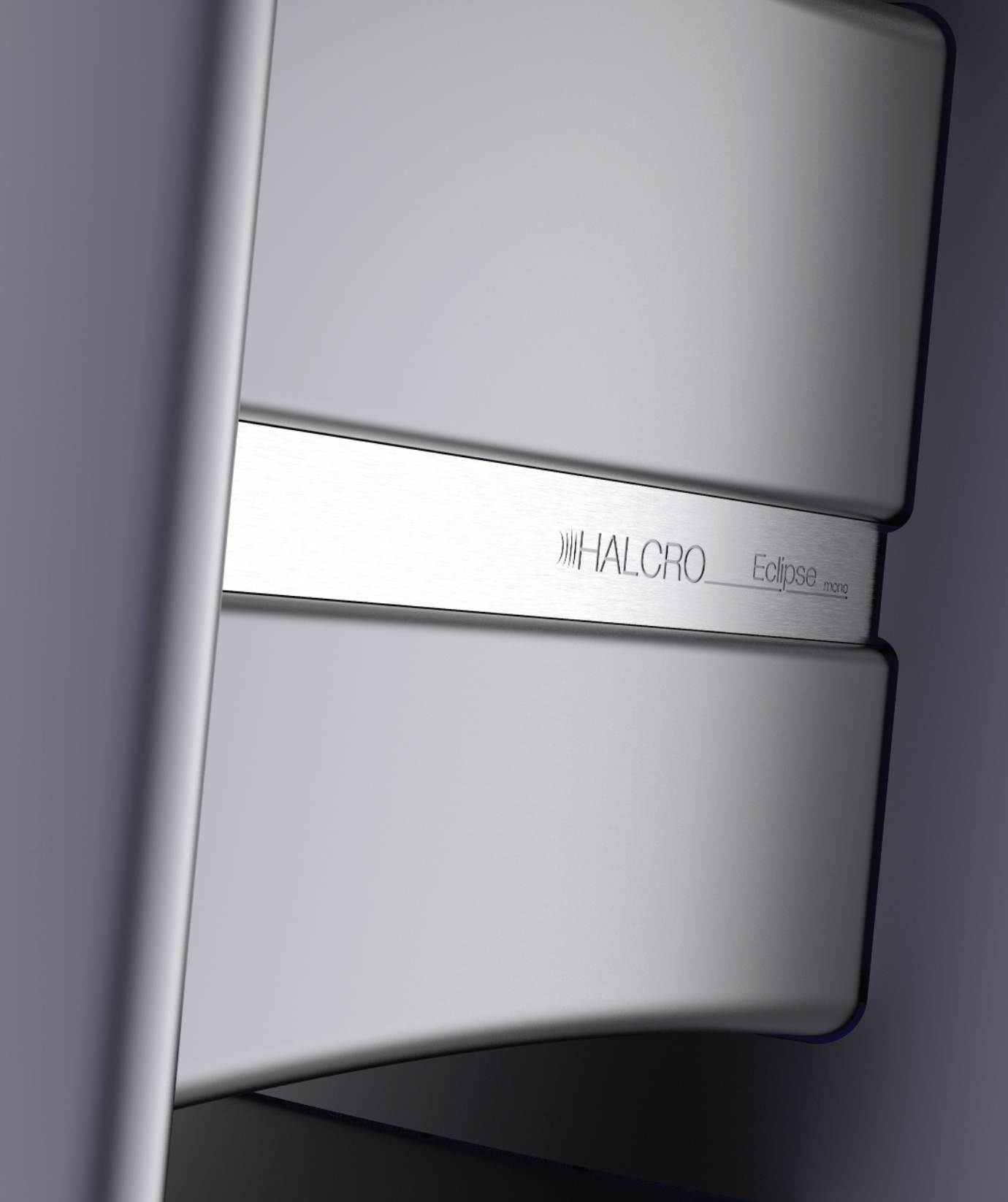
Circuit protection
As befits an amplifier with a rated output of 550 watts into 4Ω, the Halcro Eclipse Mono incorporates comprehensive protection circuitry for both the amplifier itself and its power-factor-corrected power supply. Halcro says the Eclipse Mono amplifier circuit has thermal protection against overheating, will shut it down if the output current exceeds an average of 12 amps continuously, or in the event of a short-circuit or a continuous d.c. offset, plus it has over-current limiting as well as short-circuit protection.
Halcro further says that the Eclipse Mono’s power supply is "protected against most mains transients," and "will cut out if most common faults are detected in the power supply (e.g. overvoltage, master clock at incorrect frequency, excessive temperatures etc)".
Listening sessions
The design of the Halcro Eclipse Monos – which you can see for yourself from the photographs – is such that they’re very easy to move around… provided that two strong people are doing it. Once they are in place, system hook-up is simple, thanks to the huge, rubber-covered gold-plated speaker terminals (two pairs per amp, to allow bi-wiring).
The main 240V power switch is underneath the amplifier, alongside a 3-pin IEC socket and a huge gold-plated, rubber covered earth terminal. The standby power switch is located underneath the uppermost case, in the centre, towards the front. It’s very large, so it’s easy to locate by ‘feel’ but equally it has a very odd ‘feel’ when it’s pressed, but I found that it does switch reliably every single time.
Power status is indicated by two LEDs that are low down on the front panel of the power supply unit: a large red LED for stand-by and a smaller blue one for ‘On’. Oddly enough, these LEDs are replicated on the rear of the amplifier as well. This is presumably because Halcro envisages some audiophiles will install their Eclipse Monos with the speaker terminals facing the listening position… and I wouldn’t blame them for doing so – the Eclipse Mono amplifiers look stunningly beautiful from all angles.
The words ‘stunningly beautiful’ can also be used to describe the sound of the Halcro Eclipse Monos, because it is simply gorgeous. Effortlessly gorgeous and staggeringly real. Listening to Sarah Vaughan singing Ain’t No Use (from her album ‘The Divine One’) you can hear instantly why her nickname was ‘The Divine One’ (though she’s equally well known by her other nickname– ‘Sassy’.)
But it isn’t only Vaughan’s voice that the Eclipse Monos illuminate. Listen to the double bass, particularly the differences in tone between high and low-stopped notes. Listen, too, to the haunting sound of Sweets Edison’s muted trumpet. Then there’s the tinkling but clear sound of Jimmy Jones’ piano, chiming in only as necessary but oh-so-effectively. But while you’re hearing all these things, what you don’t hear is the Halcro Eclipse Monos. The sound just exists in your room… like magic. A few tracks on in the same album, Every Time I See You has Vaughan demonstrating some of the vocal gymnastics at her disposal, and at the same time also giving us an inkling of where that ‘Sassy’ nickname came from! And once again the Halcro Eclipse Monos laid bare her talent like no other amplifier I have ever experienced. And I use the word ‘experienced’ rather than ‘heard’ deliberately… because the sound of the Halcro Eclipse Monos is truly a unique experience.
An unexpected delight was the precision of the stereo image created by these two monoblocs. The downfall of many monoblocs is imbalances in gain between the two completely different amplifiers, which results in image shifts. Not here! The central image is perfectly stage-centre, and all players are perfectly positioned in their places on that stage. Furthermore the sound-staging itself is also always perfect – never wider than it needs to be, but always exactly as wide as it should be. The soundstage seemed almost to be dynamic in its ability to accommodate the music being played. The ability of the Halcro Eclipse Monos to be sonically invisible was a constant joy. For example the guitar intro during Gloomy Sunday snapped me upright, even though I knew it was coming, because the illusion of there being a guitarist in the room, just in front of me and to the left, was palpable.
Guitar sound continued to captivate on Elliot Maginot’s ‘Young Old Everything In Between’, but on the second track, Monsters Of War, I marvelled not only at the tone of Maginot’s acoustic guitar, but also at the sonic impact of Mathieu Leguerrier’s kick drum and the way the tonal quality remained identical irrespective of the volume at which I was listening. Here I confess that I ended up listening at much higher levels than I normally would, because the Halcro Eclipse Monos had that curious ability to play loud without actually sounding loud… an attribute that benefits all music genres, but most particularly full-scale orchestral works. At the same time, the silences are amazing, ably demonstrated by the shockingly short silence between Monsters of War and the track that follows, Djibril.
While I could hardly say I was surprised that the separation between the two channels of the Eclipse Monos was total – they are monoblocs, after all! – the sonic effect of such total channel separation is always mind-blowing, as was amply demonstrated by the percussion at 2:47 in Bell. But it definitely pays dividends when reproducing complex sound fields. For example I always thought that the sonic maelstrom that is Koi Child could never be cleanly (and clearly) reproduced by any hi-fi system, but the combination of the Halcro Eclipse Monos and Vivid Audio Kaya 90s proved me wrong. During the rap of Cruzy I could hear Cruz’s vocal perfectly, while Van’s bass guitar remained super-solid and Christian’s tenor sax just sounded superior. The PRAT the Halcro Eclipse Monos exhibited throughout this album—and all of my sessions—was exceptional.
It was also exceptional on the Miles Davis track Blow (or, as I like to call it, Hello, you have no messages) from his last studio album ‘doo-bop’. The frenetic percussion is faultlessly reproduced, the depthiness of the bass is luminary and the ‘fullness’ of the sound-field exemplary. I have never heard this track sounding as good before. Listening to Miles’ Australian connection (the soundtrack to the film ‘Dingo’), the echoed trumpet lines are achingly soulful and, with the bird and cricket noises, the Halcro Eclipse Monos delivered the true sound of the Australian outback. The ‘coo-ee’ calls that both trumpeters (the other being Chuck Findley) extract from their instruments are so realistic it’s almost impossible to believe they’re issuing from a trumpet.
Final verdict
The Halcro Eclipse Mono is a superb amplifier, one whose visual presentation captures the imagination like no other amplifier I have ever seen. Its sound quality is so breathtakingly good that I had to pinch myself through my listening sessions to remind myself I was awake, and not in some blissful audiophile dream. They're certainly not cheap - though recent changes in Halcro's distribution model and a streamlined paint process have reduced them from the launch price of AU$135,000 a pair to now a US dollar price of $69,990 a pair (around AU$91,000 as we write). But to describe the performance of the Halcro Eclipse Monos, I can do no better than echo the praise of Stereophile’s Paul Bolin, who in turn paraphrased Shakespeare to say: "Feed them the best, and the Halcros will give you an experience that is such stuff as dreams are made on".
Lab testing
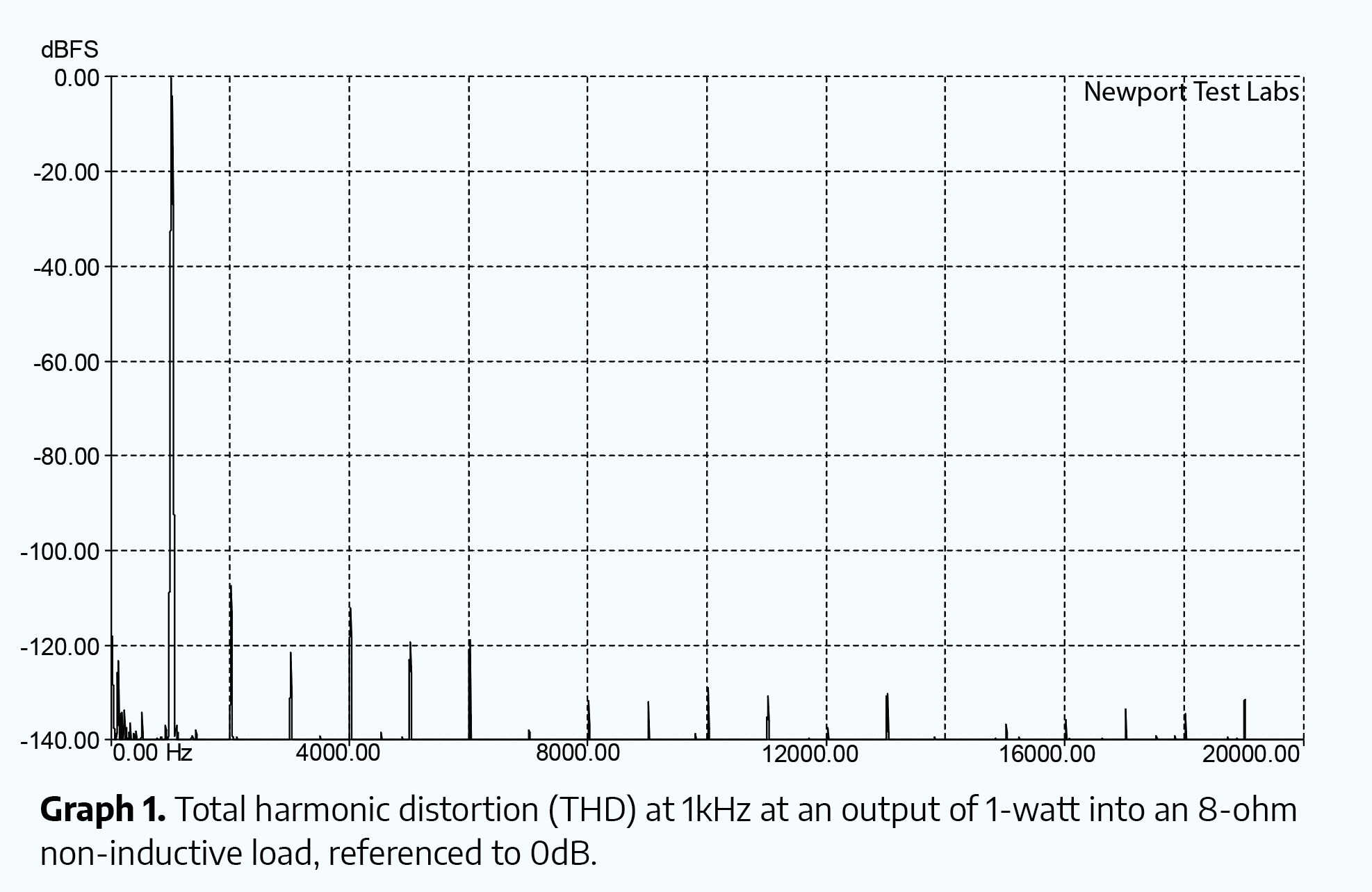
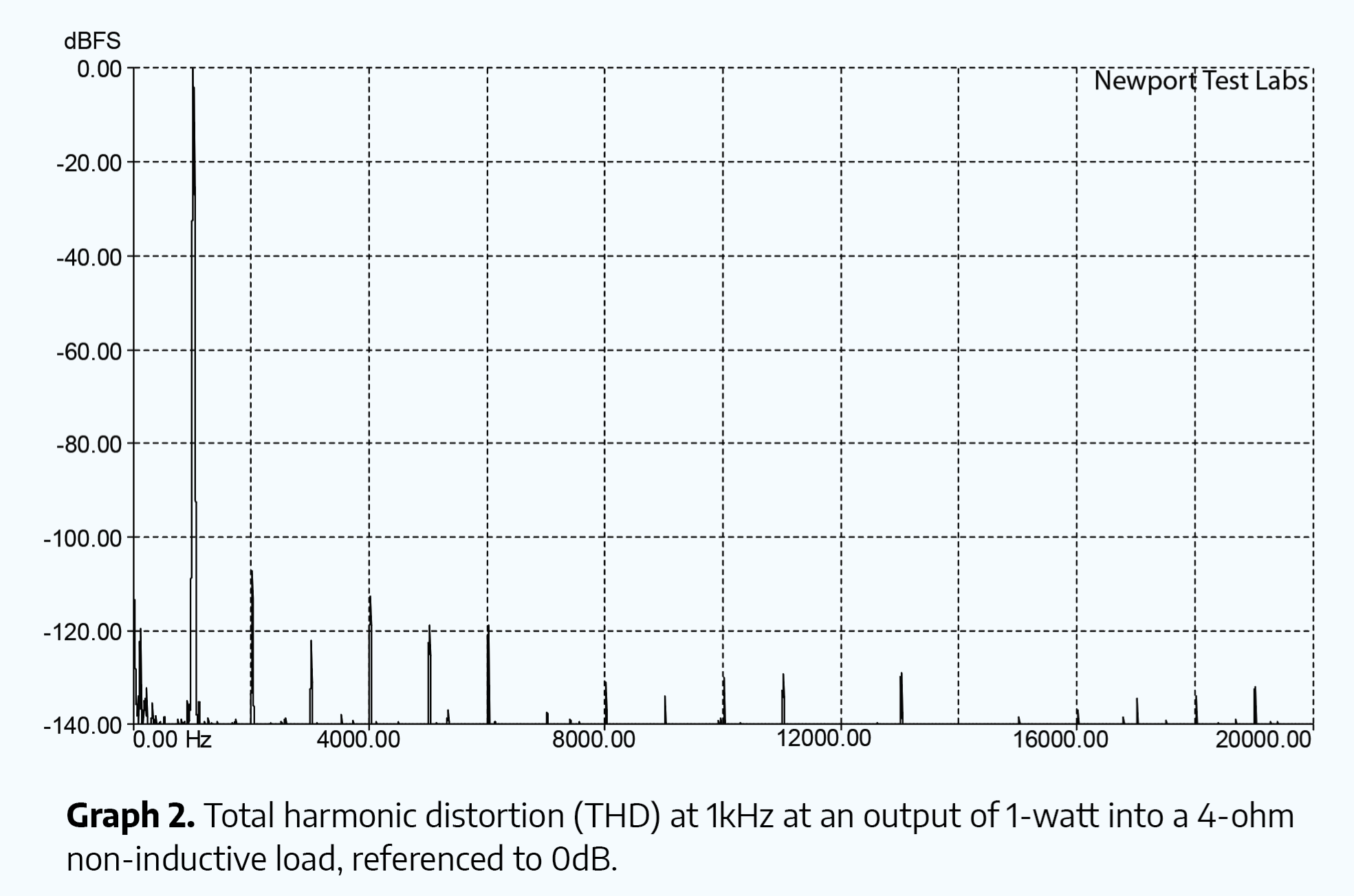
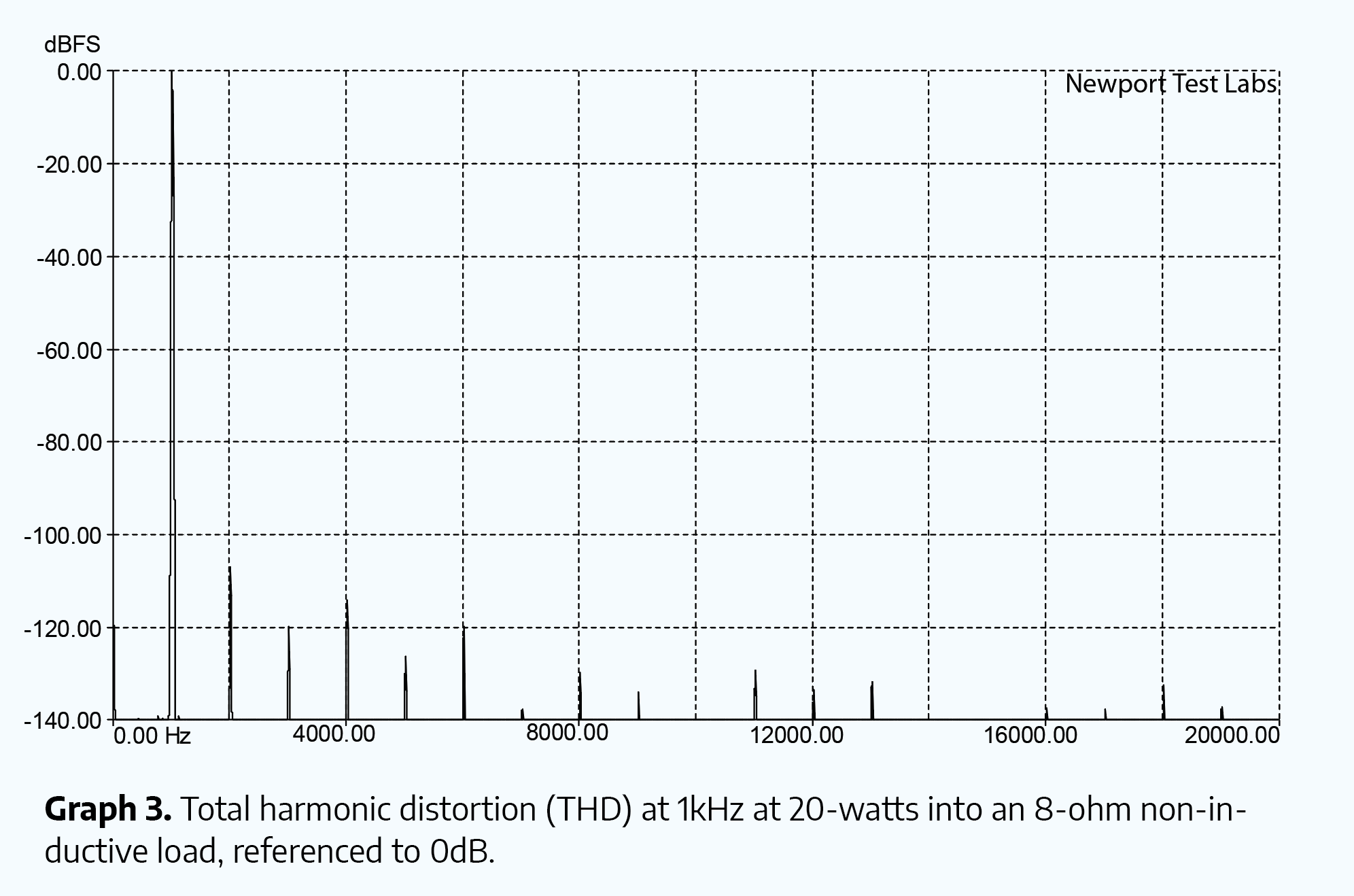
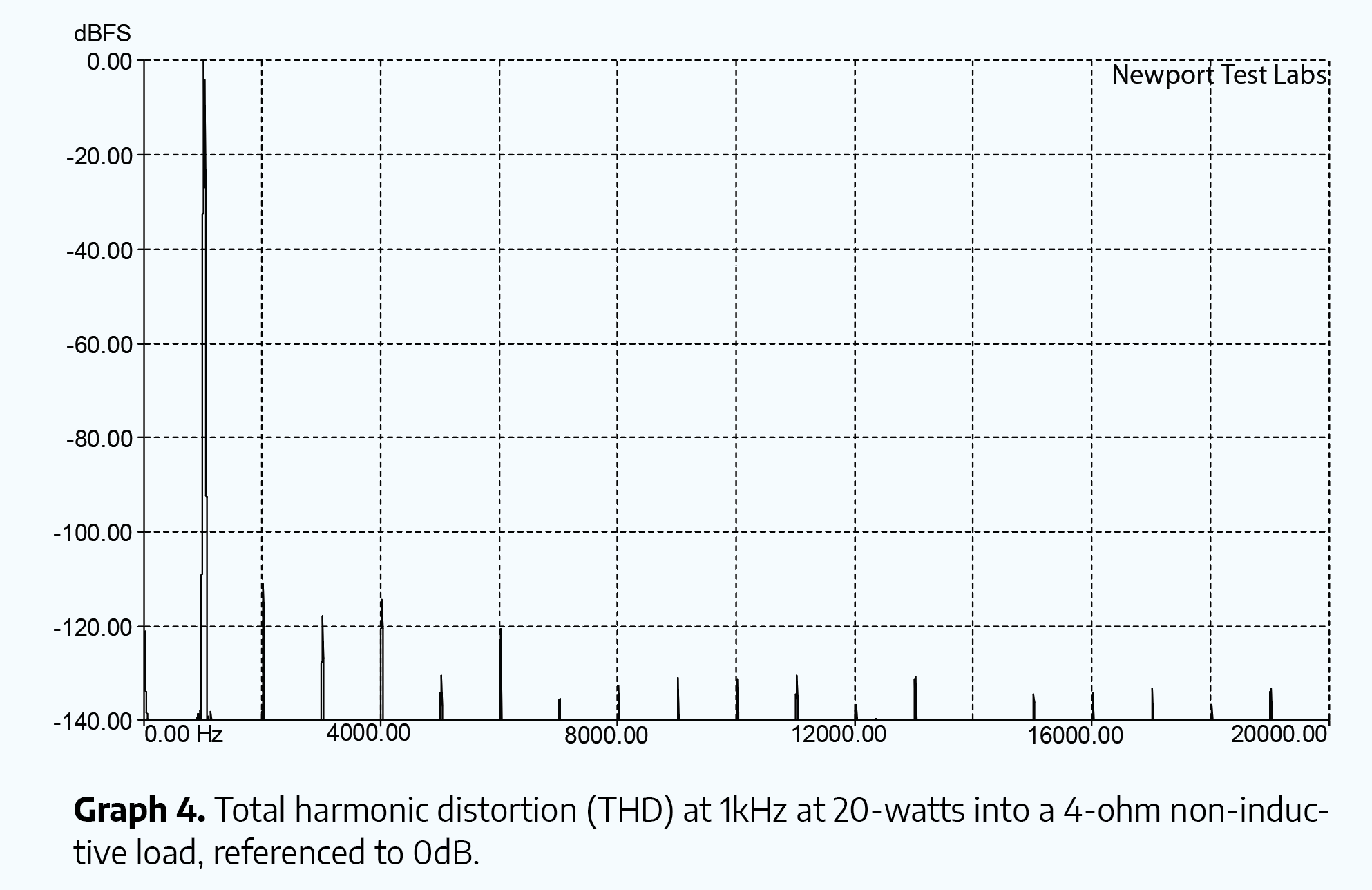
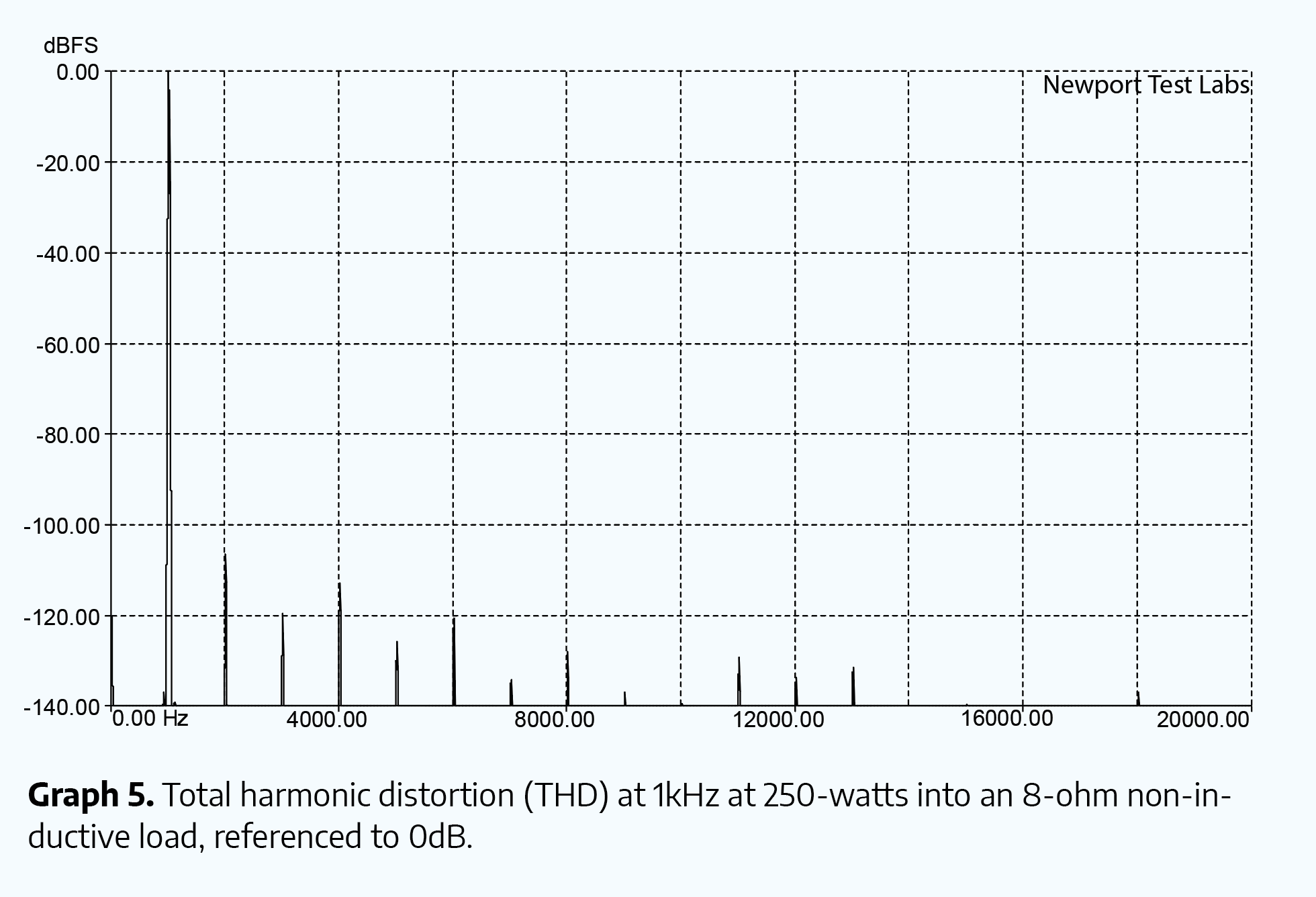
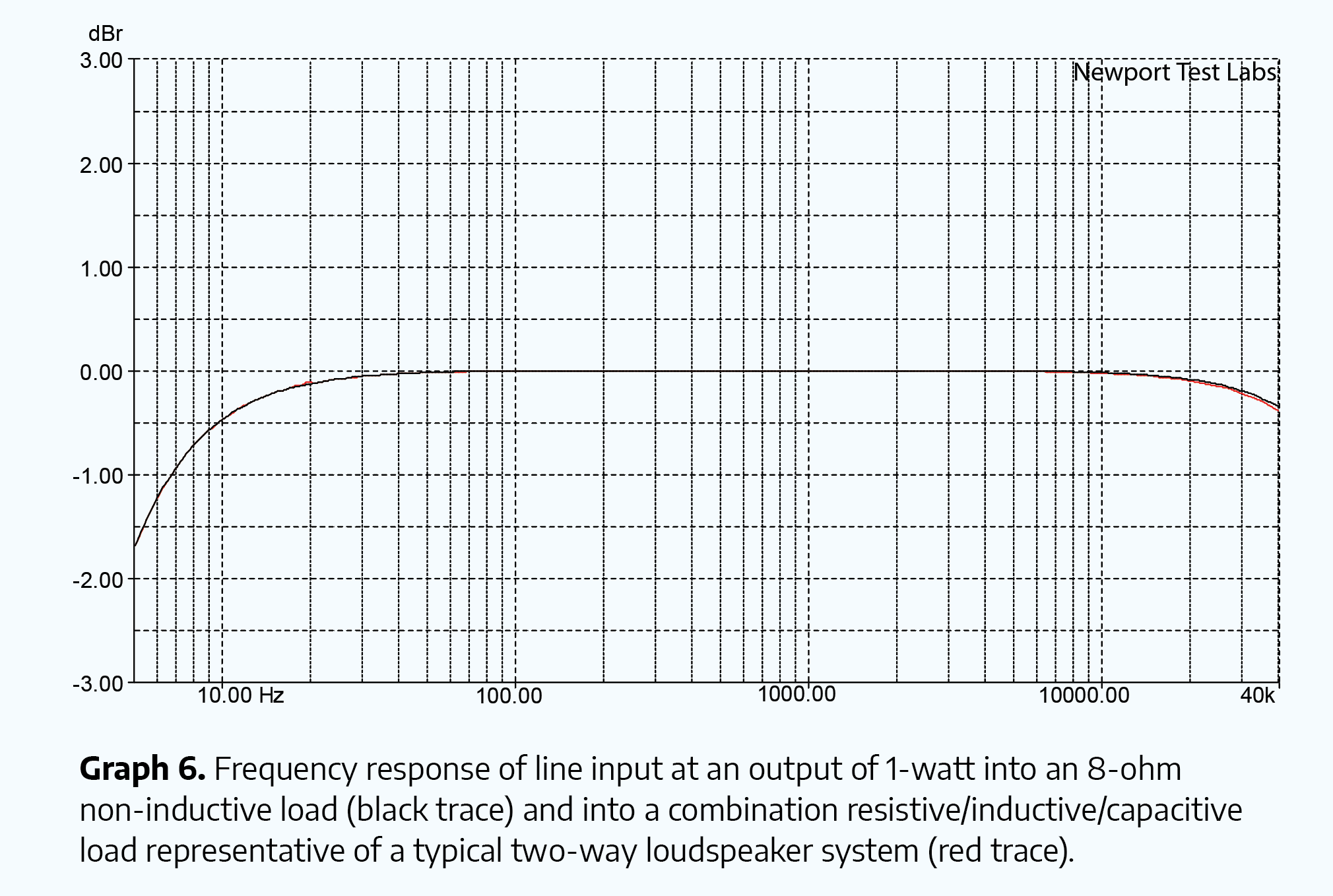
The frequency response of the Halcro Eclipse Mono power amplifier was amazingly good, and for several reasons. Firstly, it’s extended, most particularly so at the extreme high frequencies, where Newport Test Labs measured the 3dB downpoint at 217kHz. The amplifier’s low-frequency response was 3dB down at just 3Hz. Outstanding. The 1dB down-points were equally amazing, with the 1dB downpoint at 6.5Hz and the high-frequency 1dB downpoint at 91kHz. This puts the overall normalised frequency response at 6.5Hz – 91kHz ±0.5dB.
But if the wideband response was amazingly good, then the response across the audio band, particularly into a simulated loudspeaker load, was spectacularly good. This response is shown in Graph 6. You will have to look hard to see it – despite the expanded vertical scale of this graph – but there are actually two frequency response traces on this graph. The black trace shows the Halcro Eclipse Mono’s frequency response into a standard, non-inductive 8Ω resistor. You can see that it’s just 0.1dB down at 20Hz and 0.09dB down at 20kHz (and 0.03dB down at 40kHz). This puts the normalised audio-band frequency response at 20Hz–20kHz ±0.05dB. This is spectacularly good, but I have seen other amplifiers that can do this.
But if you look closely at the graph, you can see that there is a red trace there as well. That red trace is the frequency response that Newport Test Labs measured when the Halcro Eclipse Mono was driving a load that simulates that of a two-way bookshelf loudspeaker. You can see that the frequency response is exactly the same: 20Hz to 20kHz ±0.05dB. This means that unlike nearly all other amplifiers, whose frequency response will vary depending on the speakers you use with them, that of the Halcro Eclipse Mono will not.
On reading this (or seeing the graph) technically-minded readers will head immediately for Newport Test Lab’s measurement of output impedance, so they can calculate the damping factor. They will see on that tabulated graph that the measured output impedance was an incredible low 0.003Ω, which gives a damping factor of more than 2,000! I have never… ever… seen an amplifier with such a low output impedance (and thus such a high damping factor). It’s this super-low output impedance that ensures that the Halcro Eclipse Mono will drive all loudspeakers equally well.
Newport Test Labs measured the power output of the Halcro Eclipse Mono at 1kHz as being 277-watts into 8Ω. At 20Hz into the same load, the lab measured it as 274-watts. At 20kHz, it measured it as 283-watts. When measured using a 4Ω load, the Halcro Eclipse delivered 526-watts at 1kHz, 508-watts at 20Hz and 533-watts at 20kHz. Normally, these results would show whether or not the Halcro Eclipse Mono had met its manufacturer’s specification, but in this case, we weren’t absolutely certain about this because at the time of the test, Halcro had released only ‘Preliminary Specifications’ despite the amplifier we received being a full production model. These ‘Preliminary Specifications’ suggested that we should have measured power outputs of 300-watts into 8Ω and 550-watts into 4Ω.
Although the results measured by Newport Test Labs are very close to these figures (283-watts is only 0.25dB less than 300-watts, and 508-watts is only 0.34dB less than 550-watts, which means there would be no audible difference), we put in a call to Halcro which revealed that although the amplifier we received for review was a full production model, the rails of its power supply had apparently been inadvertently left at a lower ‘soak’ voltage that is used during production testing. The email from Halcro’s Peter Foster informed us: ‘The amps you have now were rushed to you from a pair that Lance [Hewitt] had sitting on the burn-in rig before he left [on an overseas holiday]. We quickly fitted the newly upgraded circuitry – our new production spec circuitry – and shipped them. I guess that in the rush to get them out the door, someone forgot to tweak up the output power to production spec.’
Although Newport Test Labs measured the distortion of the Halcro Eclipse Mono, and the results are shown in the accompanying graphs, the distortion of the Halcro Eclipse is so low that essentially, the lab was measuring the inherent distortion of its own test equipment. So in order to interpret the graphs shown, you will need to reference every one of them to the ‘Loop Back’ graph, which shows the distortion analyser measuring itself using a 1kHz test signal.
You can see that there are harmonic distortion components at 2kHz (–110dB), 3kHz (–125dB), 4kHz (–115dB), 5kHz (–123dB), 6kHz (–120dB), plus other higher-order harmonics.
Obviously, because these distortion components are inherent in the measurement chain, they will inevitably be in the output of the Halcro Eclipse Mono itself. So in Graphs 1- 5, you need to discount these levels of distortion at these frequencies. In Graph 1 and Graph 2, which show distortion at 1-watt into 8Ω and 4Ω respectively, you can see the Halcro has added some low-frequency noise (extreme left), plus there are tiny increases in distortion at 2kHz, 3kHz, and 5kHz. Essentially, however, the Halcro is replicating the test signal perfectly – almost zero distortion.
Distortion at 20-watts into 8Ω (Graph 3) is even lower, with the components on the graph being almost an exact replica of the signals on the ‘Loop Back’ graph. Note also that the small amount of low-frequency noise that was present at 1-watt has disappeared entirely. Distortion at 20-watts into 4Ω (Graph 4) shows some added distortion components that are not present when the amp is driving 8Ω load, but essentially, distortion is still so close to zero as makes no difference.
Incredibly, the distortion levels measured when the Halcro Eclipse was delivering almost its maximum output into 8Ω were almost identical to its performance at 20-watts – essentially no increase in distortion at all. This is an unbelievably good result… unprecedented, in fact. I have never, ever, seen such a fantastically good result from any power amplifier.
Measuring IMD turned out to be as futile measuring THD, with the lab unable to discern any differences at all between the loop-back measurements and the measurements made through the Halcro Eclipse Mono, so no graphs were produced. Although it’s likely that the amplifier does contribute some IMD to the audio signal passing through it, it’s so little that it may as well be zero. Again, truly unbelievable performance from the Halcro Eclipse Mono.
The signal-to-noise ratios Newport Test Labs measured on the Halcro Eclipse Mono are not only superb, they’re also the lowest the lab has ever measured, on any amplifier. The tabulated results tell the story here, with the lab measuring a signal-to-noise ratio of 100dB unweighted when referred to an output of just one watt… a result that the vast majority of amplifiers struggle to deliver when the results are both A-weighted and referred to rated output! As for that result, the A-weighted signal-to-noise ratio of the Halcro Eclipse Mono referred to rated output was an incredible 132dB. Once again, the Halcro Eclipse Mono set a record for this test as well, because Newport Test Labs has never… ever, in over 20 years… measured any amplifier with noise levels even approaching this result. The lack of noise is obvious in all the distortion graphs (1 through 5), where you can see that the noise floor across the audio band is more than 140dB down. Once again, no other amplifier has ever exhibited such low noise across the audio band.
The square wave test images published here are simply visual confirmation of the extended frequency response measured by Newport Test Labs. The 100Hz and 1kHz results are so clean and so ‘square’ that they could have come direct from the square wave generator. There’s no rounding, no tilt… and none of the bending that might indicate phase issues. The 10kHz square wave shows the very slight rounding that might be expected from a frequency response that’s 3dB down at 217kHz, but no aberrations otherwise. The square wave showing the performance into a highly capacitive load shows that the Halcro Eclipse Mono is completely stable: it will be able to drive any conceivable loudspeaker.
The input sensitivity of the unbalanced input of the Halcro Eclipse Mono was measured as 97mV for a one-watt output, and 1.59V for 277-watts. The input sensitivities for the balanced input were, of course, exactly double this, at 194mV for one watt out and 3.18V for 277-watts. The input sensitivity of the ‘Min Path’ input was 208mV for one watt out, and 3.4V for rated output. Since most source components cannot deliver 3.4 volts at their output terminals, this means that if you connected such a component directly to the ‘Min Path’ input, the Halcro Eclipse Mono would be unable to deliver its full rated output. However, the Min Path’s input sensitivity is still low enough that the Halcro should still deliver more than enough power to ensure satisfactory in-room listening, particularly when using efficient loudspeakers.
In Lewis Carroll’s book ‘Alice in Wonderland’, Alice said to the Red Queen: ‘One can’t believe impossible things’ only to be told by the Queen that she can’t have had much practise, because she herself had: ‘sometimes believed as many as six impossible things before breakfast.’ In this evaluation of the performance of the Halcro Eclipse Mono amplifier, I have had to believe at least two things I previously thought impossible.
The first thing I thought impossible is that any amplifier could deliver the level of performance the Halcro Eclipse Mono demonstrated on the test bench. It is, literally, unbelievably good. I also would not have believed it possible for any amplifier to improve on the performance of Bruce Candy’s original Halcro dm88, yet these tests prove beyond any doubt that the new Halcro Eclipse Mono is measurably superior.
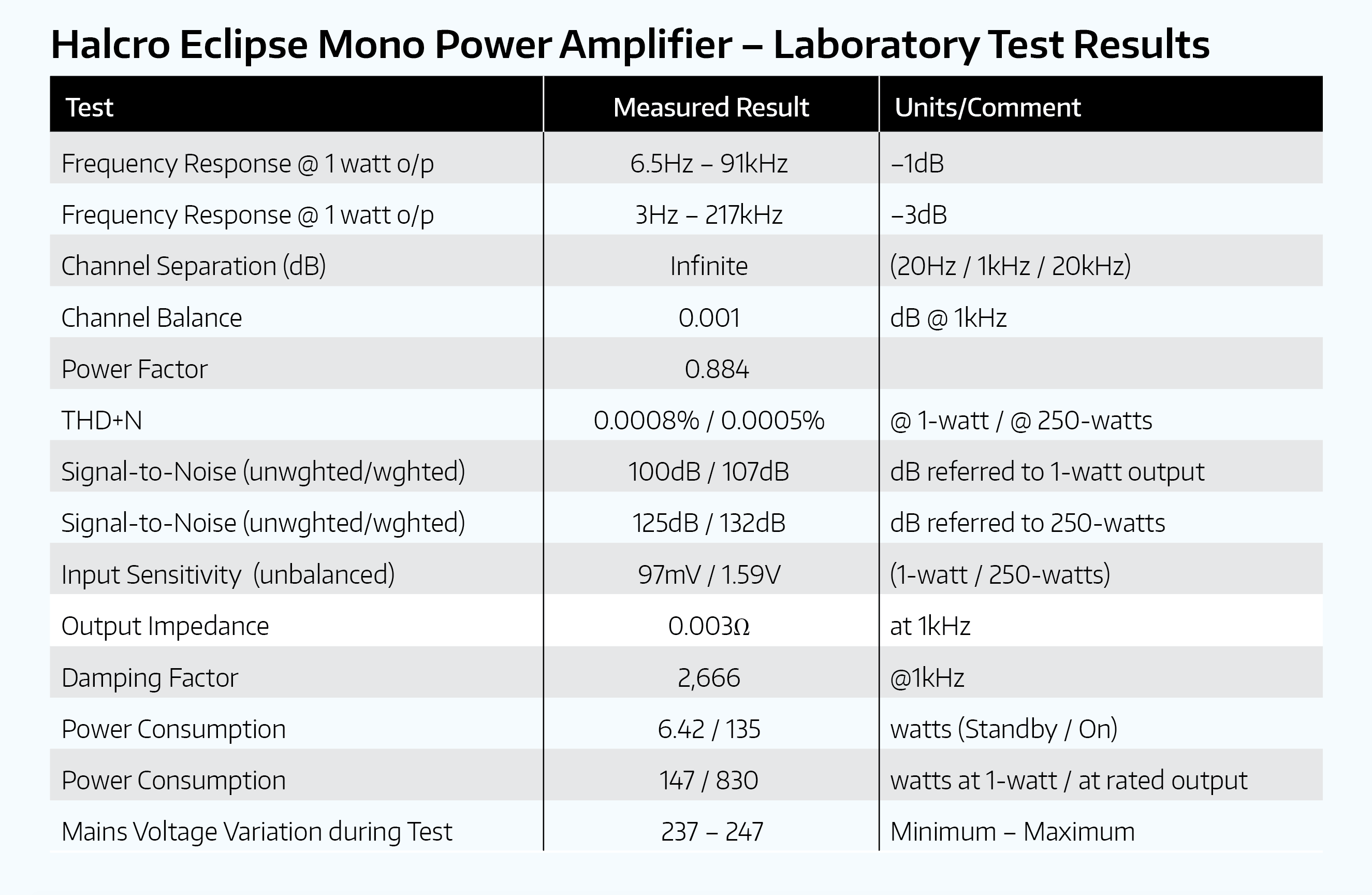
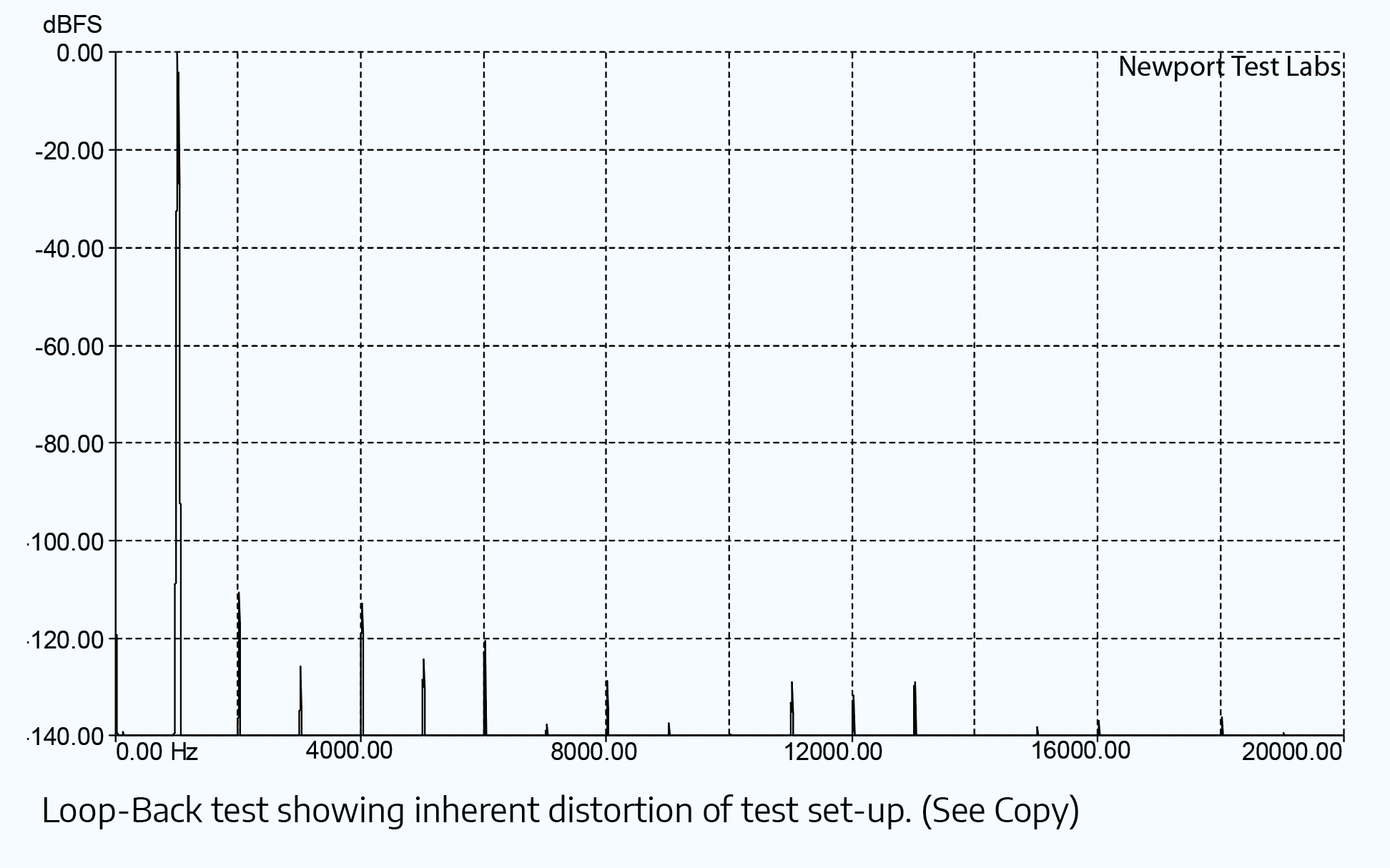

Australian Hi-Fi is one of What Hi-Fi?’s sister titles from Down Under and Australia’s longest-running and most successful hi-fi magazines, having been in continuous publication since 1969. Now edited by What Hi-Fi?'s Becky Roberts, every issue is packed with authoritative reviews of hi-fi equipment ranging from portables to state-of-the-art audiophile systems (and everything in between), information on new product launches, and ‘how-to’ articles to help you get the best quality sound for your home. Click here for more information about Australian Hi-Fi, including links to buy individual digital editions and details on how best to subscribe.
